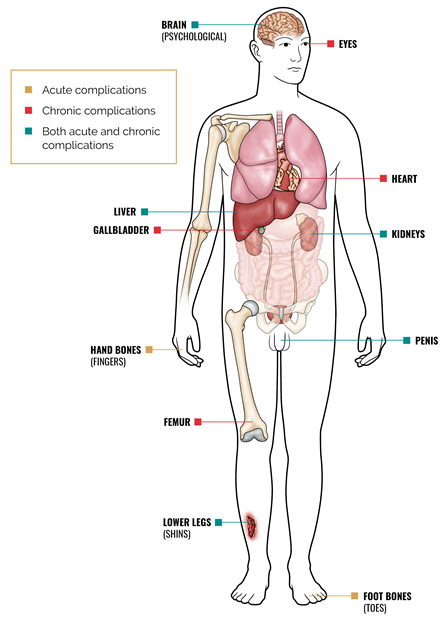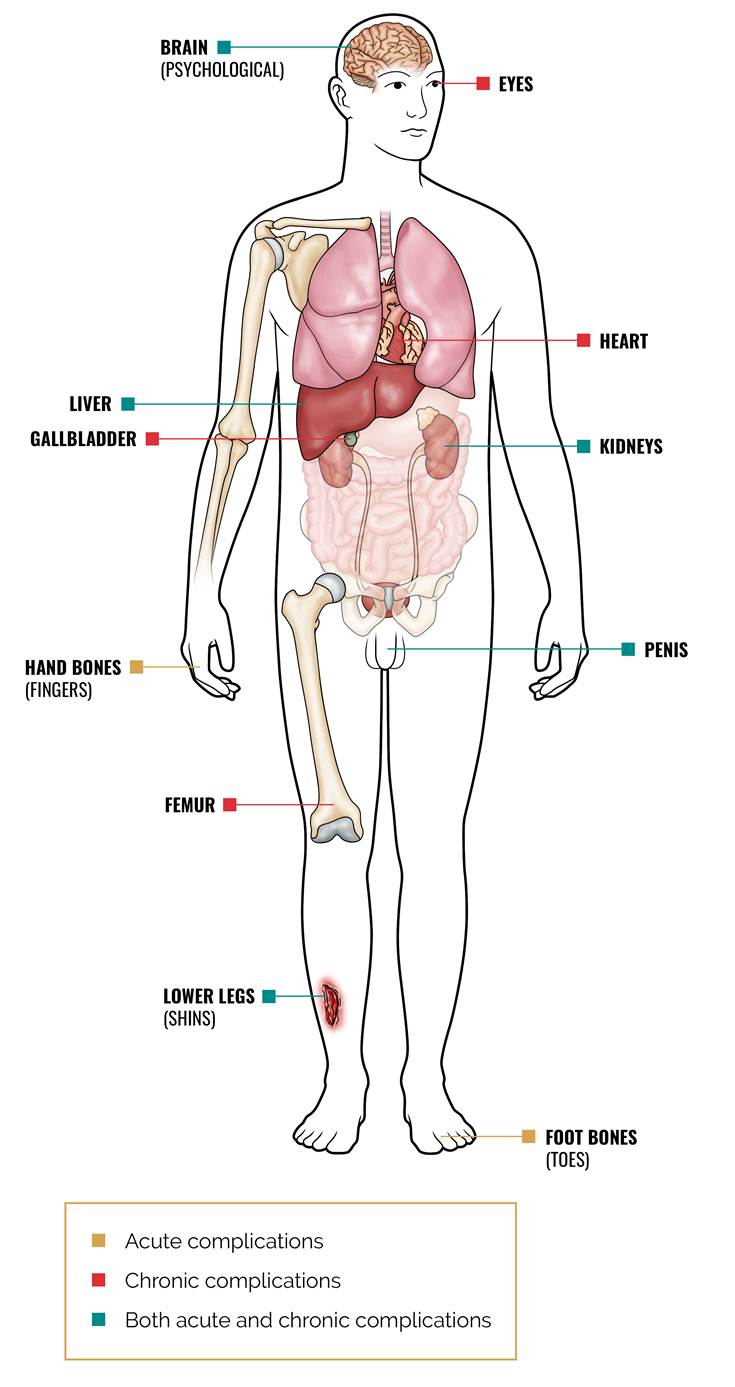Symptoms and Complications
sickle cell
Sickle Cell
Vaso-occlusion
Pain Crises
Acute Complications
Stroke
Acute chest syndrome
ACS
Liver complications
hepatic sequestration
Fever & Infections
Spleen complications
acute splenic sequestration
Prolonged painful non-sexual erections
priapism
Pain crisis in the hands and feet
dactylitis
Multisystem organ failure
In people with sickle cell, sickle-shaped red blood cells
can damage blood vessels and block blood flow throughout the vessels of the body. This blockage, known as vaso-occlusion, can prevent your organs and tissues from getting the oxygen they need and cause vaso-occlusive crises. Vaso-occlusive crises (also known as vaso-occlusive events) are a group of acute complications that include pain crises, acute chest syndrome, stroke, and problems with the spleen. These events can be triggered by many factors such as:
Anemia
chronic hemolytic anemia
Bone complications
avascular aseptic necrosis
Anxiety and depression
Chronic Symptoms and Complications
Headaches
Delayed growth and puberty
Fatigue
Gallstones
Pulmonary hypertension
Jaundice
Kidney problems
Recurrent leg sores
ulcers
Organ failure
Vision problems
retinopathy
Brain
Lungs
Liver
Spleen
Genitals
Hands & Feet
Multisystem Organ Failure
Fetal hemoglobin (HbF)
found in fetal red blood cells, and is involved in transporting oxygen from the mother's bloodstream to organs and tissues in the fetus
Anti-sickling
Preventing red blood cells from distorting into a sickle shape
Vaso-occlusive crisis
a common, painful complication of sickle cell caused by sickled red blood cells
Impact of Sickle Cell on the Body
Sickle cell is a progressive, lifelong illness that has long-term complications and affects everyone differently. Its symptoms are unpredictable and can be severe, varying from person to person, as well as for an individual over time. This unpredictability can impact the quality of life on a day-to-day basis for a person with sickle cell. It is important to remember that the silent damage of sickle cell is ongoing throughout a person’s life.
Although sickle cell is present at birth, most newborns don’t experience problems until they are ~5 months old. This occurs because fetal hemoglobin (HbF)Fetal hemoglobin (HbF)found in fetal red blood cells, and is involved in transporting oxygen from the mother's bloodstream to organs and tissues in the fetus has anti-sickling propertiesAnti-sicklingPreventing red blood cells from distorting into a sickle shape that protect their red blood cells from sickling. Normally, HbF is replaced with normal adult hemoglobin (HbA)Normal adult hemoglobin (HbA)healthy form of adult hemoglobin produced when there is no mutation in the HBB gene and it does not stick together to cause sickling shortly after birth. However, in a person with sickle cell, HbF is replaced by hemoglobin sickle (HbS), which can clump together and cause red blood cells to sickle. There are some adults who are able to maintain a high HbF level after birth; however, the impact of HbF on the body in adulthood is not yet well understood.
It’s important to note that although a person may not be experiencing symptoms, the silent damage of sickle cell to your body and organs is progressive, and frequency of symptoms may increase with age.



You can live and continue to strive, and thrive with the disease. It just has to be managed, and you have to be smart in the way you manage it."
You can live and continue to strive, and thrive with the disease. It just has to be managed, and you have to be smart in the way you manage it."
KEVIN
Living With Sickle Cell, President of Uriel Owens Sickle Cell Disease Association of the Midwest
Acute Complications, Vaso-Occlusion, and Pain Crises
Acute symptoms may come on suddenly and last for a short period of time. Although they may resolve quickly, the damage from acute complications can be ongoing. A long-term care plan may include scheduling regular checkups and monitoring symptoms to help you prevent vaso-occlusive crises, as well as planning what you should do in the event that you experience a sickle cell crisis.
In people with sickle cell, sickle-shaped red blood cells can damage blood vessels and block blood flow throughout the vessels of the body. This blockage, known as vaso-occlusion, can prevent your organs and tissues from getting the oxygen they need and cause vaso-occlusive crisesVaso-occlusive crisisa common, painful complication of sickle cell caused by sickled red blood cells. Vaso-occlusive crises (also known as vaso-occlusive events) are a group of acute complications that include pain crises, acute chest syndrome, stroke, and problems with the spleen. These events can be triggered by many factors such as:

HAVING A COLD/ILLNESS

DEHYDRATION

COLD WEATHER

WINDY WEATHER CONDITIONS

HIGHER AIR PRESSURE
Pain crises, also known as a sickle cell crisis, are unpredictable and extremely painful, lasting anywhere from a few hours to a few weeks, and are the most common reason for hospitalization. Frequency, duration, and intensity of pain crises can vary with age.
In addition to causing extreme pain, these crises can affect any part of the body where there is blood flow (that is, anywhere there are blood vessels) and can happen in more than one spot at a time.
Acute Complications
Stroke (overt and silent)
A stroke is a vaso-occlusive event that occurs when blood flow to the brain becomes blocked by sickled red blood cells, preventing the brain from getting the oxygen it needs to function; 1 out of 4 adults with sickle cell (25%) will experience a stroke by the age of 45.
Acute chest syndrome (ACS)
ACS is a vaso-occlusive event that occurs when not enough oxygen can get to the lungs when the blood vessels of the lungs become blocked by sickled red blood cells. If a person with sickle cell has a drop in oxygen levels, a cough, or difficulty breathing—particularly with a fever—they should be checked for this complication. ACS severity increases with age, and more than 10% of adult cases either cause death or are complicated by neurological events and organ failure. ACS can or will affect approximately 30% of people living with sickle cell.
Liver complications (hepatic sequestration)
Liver complications occur when sickled red blood cells become trapped and prevent proper blood flow through the liver, causing it to enlarge over a short period of time. It is reported that approximately 10% of people with sickle cell experience liver complications during a vaso-occlusive crisis.
Fever & Infections
Increased risk for infections occur when damage to the spleen affects its ability to filter blood. The Advisory Committee on Immunization Practices recommends additional immunizations for people with sickle cell as a result of progressive damage to the spleen and its effect on the immune system. If someone with sickle cell has a temperature of >101.3°F, they should call a doctor.
Spleen complications (acute splenic sequestration)
Splenic sequestration occurs when sudden trapping of sickled red blood cells in the spleen cause the spleen to grow over a short period of time and can cause blood pressure drops and severe illness, including death. This is one of the earliest life-threatening complications and occurs in 7% to 30% of young children with sickle cell, usually between 5 and 24 months of age.
Prolonged painful non-sexual erections (priapism)
Priapism occurs when sickled red blood cells become trapped in the penis causing painful, involuntary erections that can lead to erectile dysfunction over time. Although this complication is likely underreported, it is estimated to affect anywhere from 11% to 67% of males with sickle cell.
Pain crisis in the hands and feet (dactylitis)
Dactylitis is a result of blocked blood vessels and causes painful swelling of the hands and feet, especially in young children. Approximately 30% of children with the hemoglobin SS form of sickle cell—the most common type—will have dactylitis within the first 3 years of life, with two-thirds occurring between 6 months and 2 years of age. Experiencing dactylitis after the age of 5 is less common.
A catastrophic vaso-occlusive crisis from a severe trigger can lead all organs to fail due to sickling in the whole body.
Acute Complications


Chronic Symptoms and Complications
The underlying damage caused by acute complications can lead to more serious complications. Even when you are not in pain, ongoing blockages, damage to the blood vessels, and the breaking down of sickled red blood cells over time can lead to progressive and chronic (arising over a longer period of time) complications including organ damage or even failure. These complications can include:
Bone complications (avascular aseptic necrosis)
Occurs when sickled red blood cells cause blockages that decrease blood flow to the bones, such as thigh bones. The lack of blood flow can cause damage to joints throughout the body. Bone complications are associated with crippling pain that can occur as early as 5 years of age. They are most commonly diagnosed in those with sickle cell in their 30s. For some people, surgery may be required to repair the bone damage.
Chronic pain
Ongoing back, joint, and bone pain is a result of damage to nerve endings from having recurrent pain episodes. Chronic pain is common among people with sickle cell and generally intensifies with age.
Anxiety and depression
Anxiety and depression affect about 35% of people living with sickle cell, which is approximately 5 times greater than that of the general population.
Headaches
Headaches occur due to low blood counts caused by the premature breakdown of red blood cells (hemolysis) as well as blockages from sickled red blood cells in the blood vessels that decrease blood flow to the brain. Severe headaches can be a sign of a migraine or even a stroke.
Delayed growth and puberty
Children with sickle cell may experience slower development and sexual maturity. This is because their bodies do not receive the oxygen and nutrients needed for growth as a result of the premature breakdown of red blood cells.
Fertility and pregnancy
Both males and females with sickle cell can experience issues with fertility. In males, this includes low levels of testosterone, sperm abnormalities, and erectile dysfunction. Although research is limited, scientists think these issues are a result of blocked blood vessels of the testicles. Some sickle cell treatments can also impair fertility.
Research on fertility challenges in females with sickle cell is lacking. However, there are known risk factors caused by reduced blood flow that can affect a female’s ability to become pregnant, including a lack of blood supply to the ovaries and chronic inflammation. Additionally, women with sickle cell may be at an increased risk for high blood pressure and blood clots during pregnancy, as well as miscarriage, premature birth, and having a child with low birth weight.
Vision problems (retinopathy)
Retinal detachment and vision loss can result from blocked or bleeding blood vessels caused by damage to blood vessels in the eye from sickled red blood cells. People with this condition may not be able to feel the damage that is happening, so it is important to have regular eye exams. This occurs in approximately 38% to 76% of people, depending on the type of sickle cell.
Gallstones
Gallstones occur when sickled red blood cells break down and their contents form into stones in the gallbladder causing pain on the right side of the abdomen, especially after eating. Gallstones occur in approximately 10% of children aged 2 to 4, and more than 50% in adults with sickle cell.
Pulmonary hypertension
Blockages and premature breakdown of sickled red blood cells can damage blood vessels that transport blood from the heart to the lungs. As a result, people with sickle cell can develop high blood pressure in their lungs. Pulmonary hypertension occurs in approximately 6% to 11% of people with sickle cell.
Cardiovascular complications
These complications increase with age and are a common cause of death for people living with sickle cell disease.
Kidney problems
Blockages caused by sickled red blood cells that prevent proper blood flow can damage kidneys and limit their ability to filter blood and concentrate urine. This may cause nighttime wetting as well as chronic kidney disease (CKD), and can potentially lead to kidney failure (also known as renal failure).
Recurrent leg sores (ulcers)
Poor circulation due to restricted blood flow caused by sickled red blood cells can contribute to the formation of ulcers in people with sickle cell. The painful sores often appear on the lower part of the leg and grow over time. Leg ulcers usually do not affect a person with sickle cell until after the age of 10.
Anemia (chronic hemolytic anemia)
Anemia occurs when sickled red blood cells break apart and die faster than the body can replace them, reducing the amount of oxygen throughout the body. This shortage of red blood cells can also cause fatigue.
Fatigue
Fatigue in a person with sickle cell can be a result of several factors, including: anemia caused by too few red blood cells and reduced oxygen circulating throughout the body; depression due to the impact on quality of life; and/or use of pain medications to treat acute and chronic pain.
Organ failure
Repeated blockages and long-term damage from sickled red blood cells eventually cause an organ to completely stop working. This occurs in 59% of adults with sickle cell due to chronic complications and can affect multiple organs or systems in the body.
Jaundice
Jaundice occurs when sickled red blood cells break down prematurely and leak bilirubin, a yellow chemical in hemoglobin. This results in higher-than-normal levels in the system, causing the skin and the whites of the eyes to yellow.
Chronic complications are a significant cause of illness in adults with sickle cell—they may go unnoticed and can cause damage to organs and other parts of the body. This long-term damage is expected and deserves careful monitoring and management with your healthcare team. Creating a care plan may help limit the progression of these complications, and help you maintain your overall health as best as you can.
Recognizing the impact your symptoms have on your health now and in the long-term may help you have more productive conversations when discussing comprehensive care with your healthcare team. Take a short quiz to see how sickle cell impacts you.



I would say the pain varies. Sometimes it’s just like a pressure—just being squeezed or bones are breaking or being stressed. Sometimes it’s pointy, like a thousand needles kind-of-pain…"
I would say the pain varies. Sometimes it’s just like a pressure—just being squeezed or bones are breaking or being stressed. Sometimes it’s pointy, like a thousand needles kind-of-pain…"
TREY
Living With Sickle Cell
What Can You Do?
for your sickle cell.



